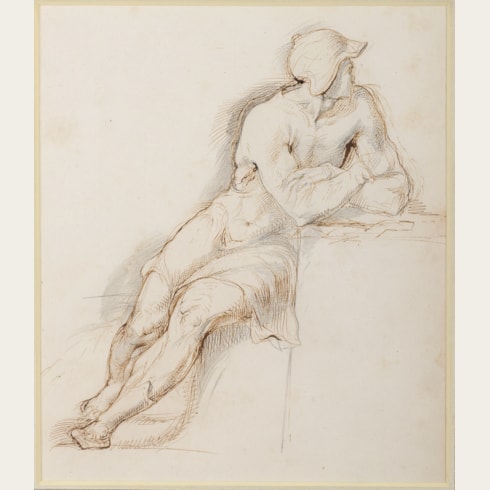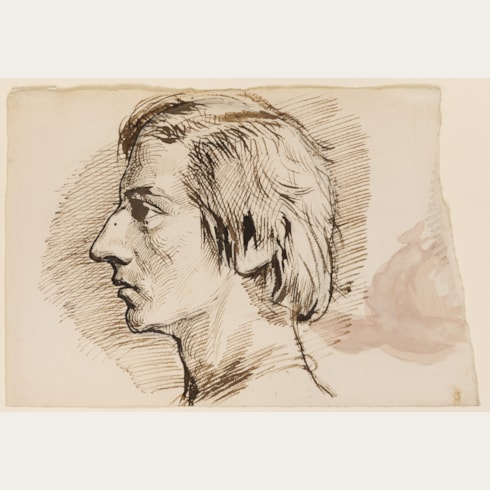George RICHMOND
(Brompton 1809 - London 1896)
Copy after a Cast of the Right Arm of Michelangelo’s David
Sold
Pencil and pen and brown ink.
A faint sketch of a seated figure drawn in pencil on the verso.
Inscribed and signed with initials 'From M Angelo - / GR' and dated 1828 in pencil at the lower right.
276 x 97 mm. (10 7/8 x 3 7/8 in.)
A faint sketch of a seated figure drawn in pencil on the verso.
Inscribed and signed with initials 'From M Angelo - / GR' and dated 1828 in pencil at the lower right.
276 x 97 mm. (10 7/8 x 3 7/8 in.)
Like his mentor William Blake, George Richmond preferred the work of Michelangelo to that of Raphael, and his youthful drawings often emulate the pen and ink manner of the Italian master’s draughtsmanship. As Susan Sloman has noted, ‘Richmond was struck more forcibly than the other Ancients by Blake’s indebtedness to Michelangelo and used his own rapidly-developing powers as a draughtsman to pick up this particular thread from Blake and make it his own.’ In 1838 Richmond travelled with Palmer to Rome. There he finally came into direct contact with the works of Michelangelo, of whom he noted in a diary entry, following a visit the Sistine Chapel, that ‘he indeed was the King of Art’.
The Royal Academy Schools are known to have had a cast of the right arm of Michelangelo’s David in the Antique Room, from which Richmond must have drawn the present sheet, since he did not visit Florence until 1838. In an entry in his early Account Book, dated June 1827, Richmond noted that he had made ‘A finished drawing of Michael Angelos Arm’, while a year later, in June 1828, he wrote that he ‘Made a moddel [sic] of MA Arm’; the second of these two entries may refer to the present sheet. Another Michelangelesque study by Richmond after a cast of the right arm of the David appears on a sheet of studies – drawn in a combination of red chalk, pen and ink, and pencil and also dated 1828 - in the Ashmolean Museum in Oxford.
Richmond may well have referred to the present sheet or the Ashmolean drawing when preparing his Michelangelesque tempera painting Christ and the Woman of Samaria of the same year, now in the collection of Tate Britain3. In the Tate painting, the bare arm of the Samaritan woman is very close to the right arm of the David as studied in both this drawing and that in the Ashmolean.
When Richmond came to eventually see, at first hand, Michelangelo’s monumental sculpture of David in the Piazza della Signoria in Florence, he wrote in praise of it that it had ‘a nerve, spring and life about [it] which reduces the two works of Bandinelli near it quite to stone, they are large but this is great, they are muscular but this has strength, they are there for ever but this might walk away.’3 As he also wrote, ‘The more I see of those who copy M[ichael] A[ngelo] the more steadily convinced I feel that he of all men in art will least adorn an imitation – one can bear to be reminded through an imitation of Leonardo, Rafaello and the other great painters but M.A. thoughts can only be well read in his own language and it is the perfect harmony between the thoughts and the expression of it that enables to first bear and then to admire the labours of the mighty man.’
The Royal Academy Schools are known to have had a cast of the right arm of Michelangelo’s David in the Antique Room, from which Richmond must have drawn the present sheet, since he did not visit Florence until 1838. In an entry in his early Account Book, dated June 1827, Richmond noted that he had made ‘A finished drawing of Michael Angelos Arm’, while a year later, in June 1828, he wrote that he ‘Made a moddel [sic] of MA Arm’; the second of these two entries may refer to the present sheet. Another Michelangelesque study by Richmond after a cast of the right arm of the David appears on a sheet of studies – drawn in a combination of red chalk, pen and ink, and pencil and also dated 1828 - in the Ashmolean Museum in Oxford.
Richmond may well have referred to the present sheet or the Ashmolean drawing when preparing his Michelangelesque tempera painting Christ and the Woman of Samaria of the same year, now in the collection of Tate Britain3. In the Tate painting, the bare arm of the Samaritan woman is very close to the right arm of the David as studied in both this drawing and that in the Ashmolean.
When Richmond came to eventually see, at first hand, Michelangelo’s monumental sculpture of David in the Piazza della Signoria in Florence, he wrote in praise of it that it had ‘a nerve, spring and life about [it] which reduces the two works of Bandinelli near it quite to stone, they are large but this is great, they are muscular but this has strength, they are there for ever but this might walk away.’3 As he also wrote, ‘The more I see of those who copy M[ichael] A[ngelo] the more steadily convinced I feel that he of all men in art will least adorn an imitation – one can bear to be reminded through an imitation of Leonardo, Rafaello and the other great painters but M.A. thoughts can only be well read in his own language and it is the perfect harmony between the thoughts and the expression of it that enables to first bear and then to admire the labours of the mighty man.’
A disciple of Willam Blake and a close friend of Samuel Palmer, George Richmond formed - with Palmer, Edward Calvert and other followers of Blake - a small group who called themselves ‘The Ancients’. The only member of ‘The Ancients’ who received a conventional academic training, Richmond entered the Royal Academy Schools in December 1824, at the age of just fourteen, and there studied under Henry Fuseli. It was while he was at the Academy Schools that he first showed himself to be an accomplished and gifted draughtsman. Between 1824 and 1828 Richmond often joined Blake, Palmer, John Varley and others at John Linnell’s Hampstead home to draw from nature, as he also did with Palmer at Shoreham in Kent for several weeks in 1827. After his marriage in 1831, Richmond began working primarily as a portrait painter, quickly achieving a considerable measure of success. Although much influenced by Michelangelo and Italian art of the Renaissance, it was not until 1838 that Richmond was able to visit Italy, when he travelled with Palmer to Rome. In the 1840s he became friendly with John Ruskin, of whom he produced two portraits, exhibited at the Royal Academy in 1843 and 1857; the second of these was later engraved. Elected to the Royal Academy in 1866, Richmond’s stature in the London art world was such that he was twice offered the directorship of the National Gallery, which he twice declined. It is as a portraitist that Richmond is best known today, and which accounts for the bulk of his extant oeuvre as a painter. As his biographer Raymond Lister has noted, ‘Richmond was in fact at his greatest as a portrait painter. Despite yearnings to express himself in other ways, despite his early promise as a visionary painter, it is in portraiture that his true stature is to be seen.’
Provenance
By descent in the family of the artist
Private collection, UK.







